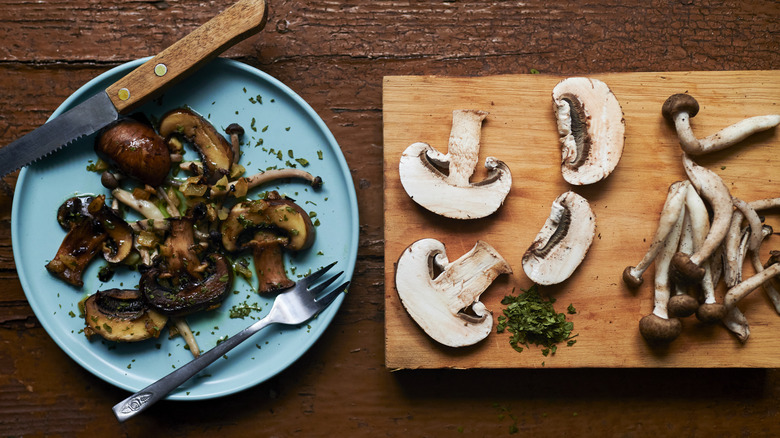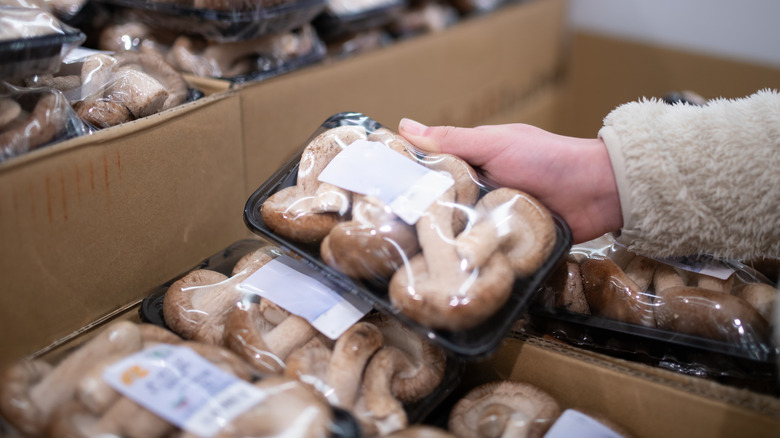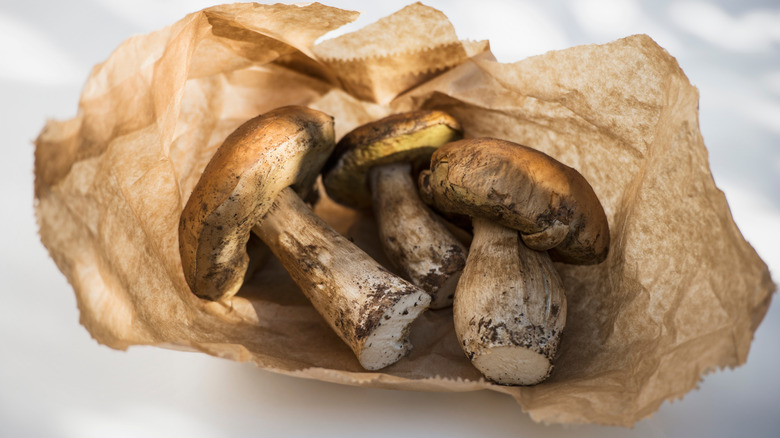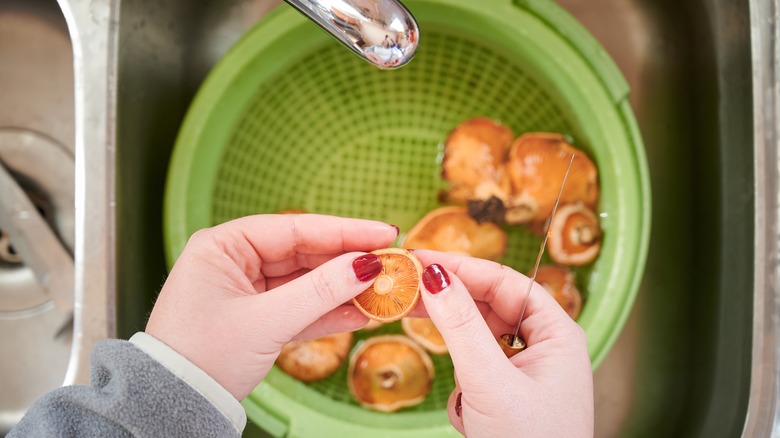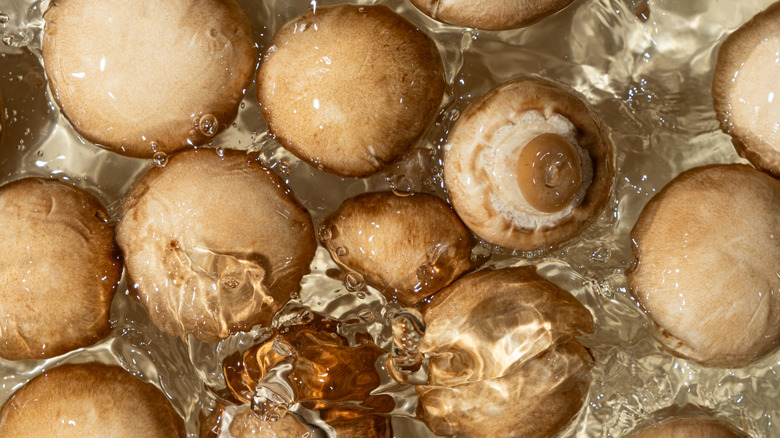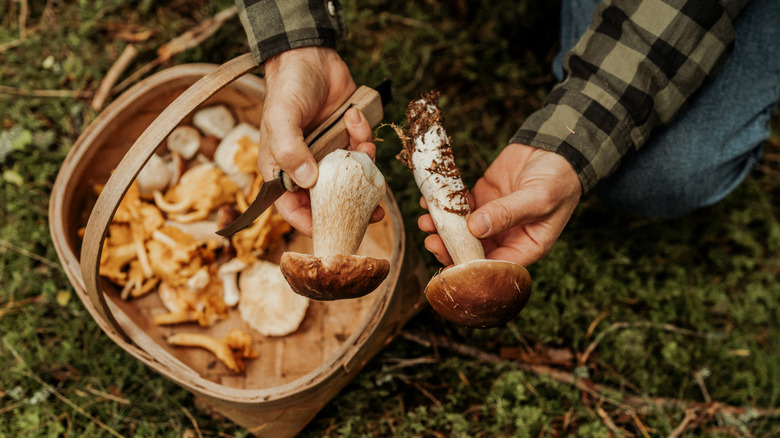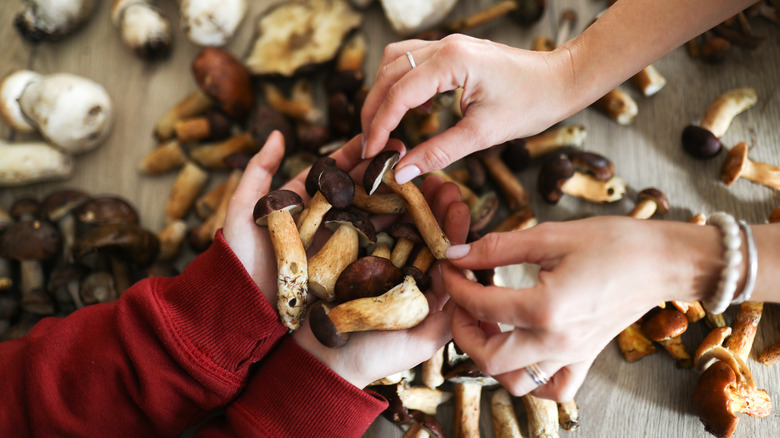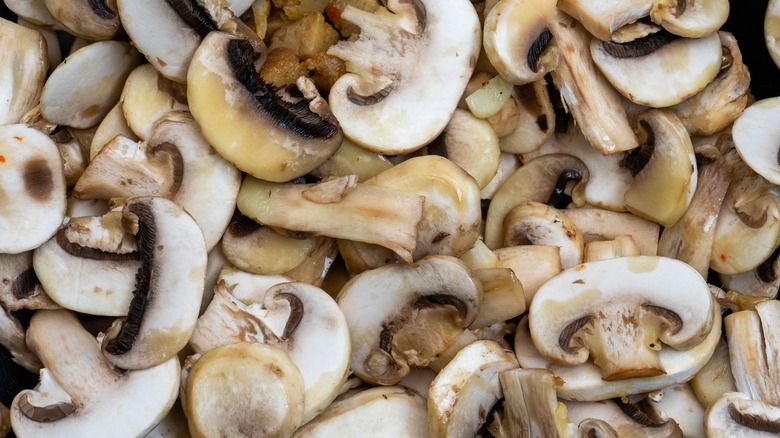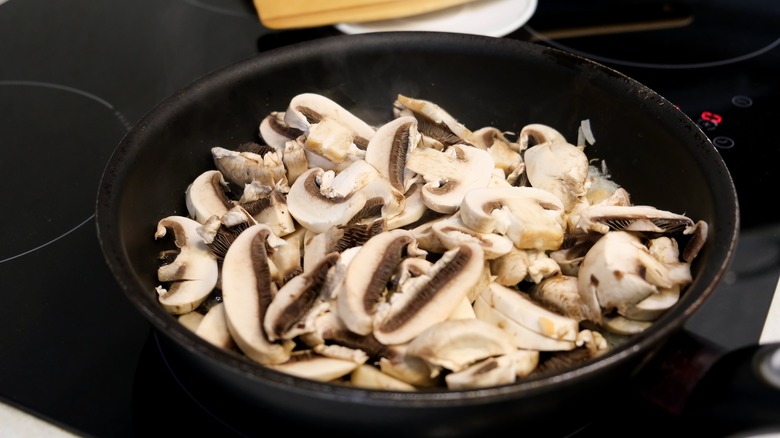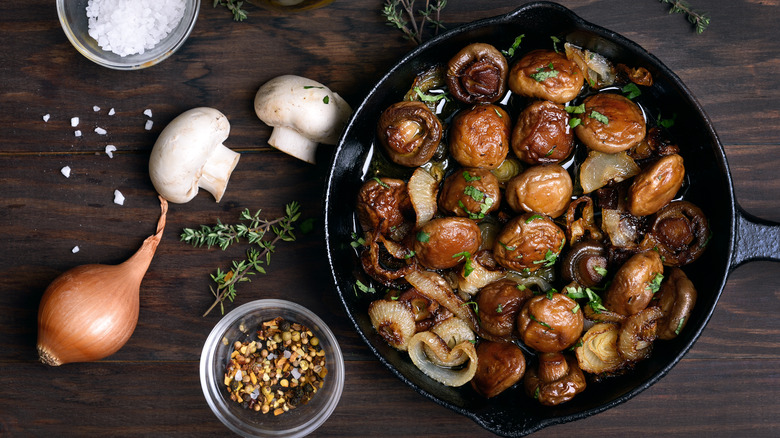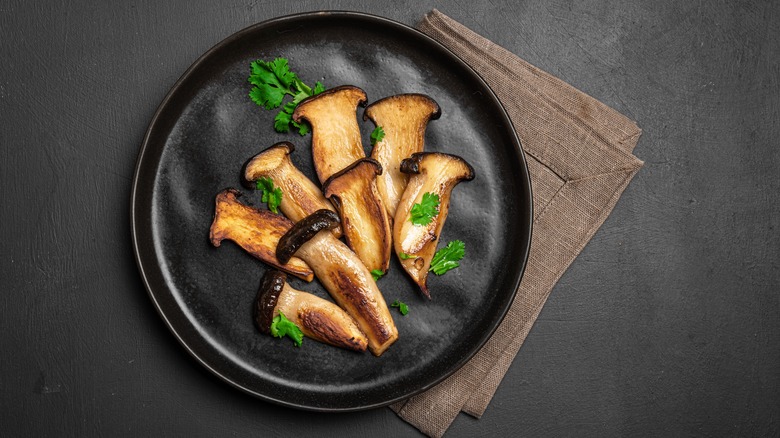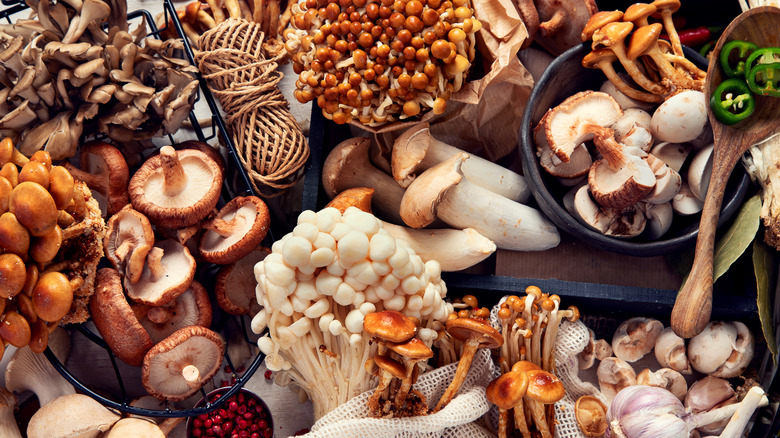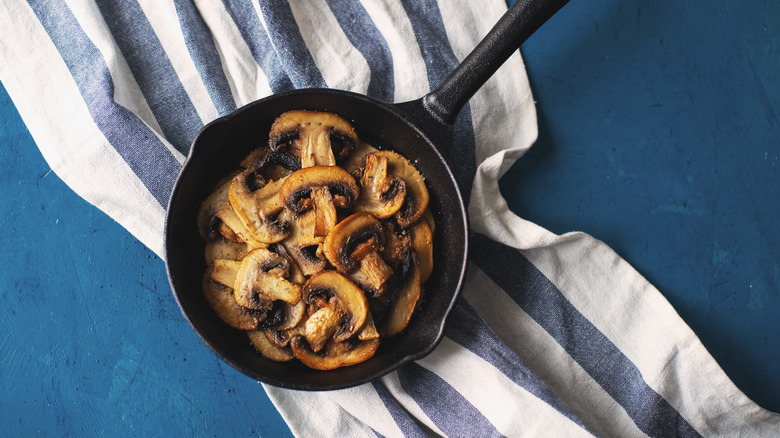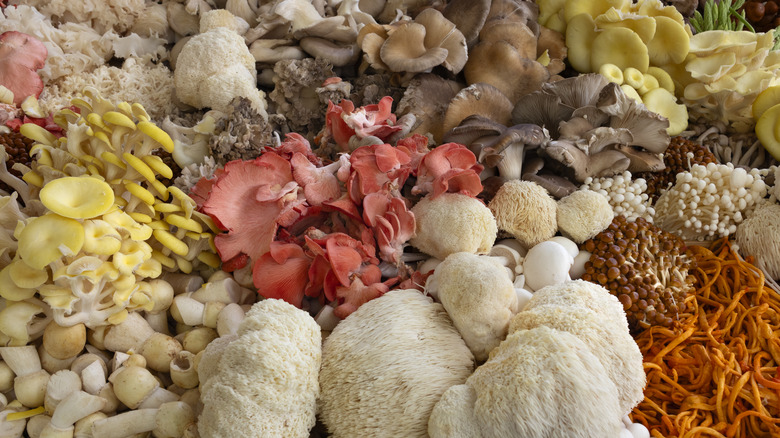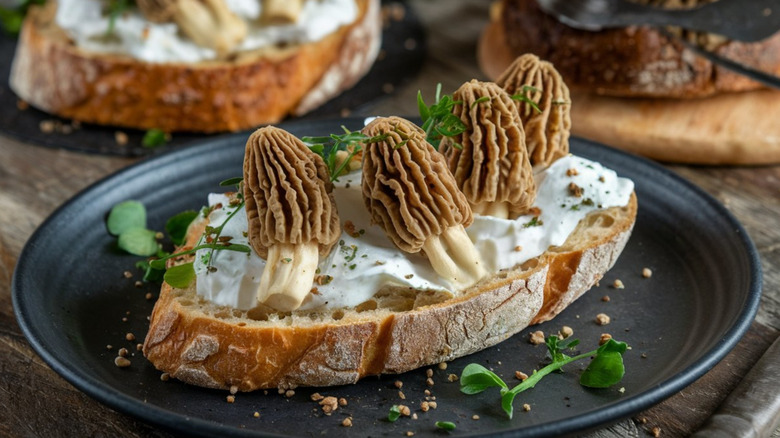Experts Break Down The 14 Common Mistakes To Avoid When Cooking Mushrooms
Mushrooms remain a versatile ingredient for many home cooks and chefs. Meat-eaters and vegans alike love these savory, umami-flavored morsels, acknowledging the intriguing elements they can add to various dishes from vegan soups to salisbury steak. Although the process for cooking mushrooms may seem straightforward, there are quite a few common mistakes people make when preparing these earthy delights. From ingredient pairings and preparation techniques to different cooking methods based on the type of mushroom chosen, there are a great many pitfalls one can fall into when dishing up mushrooms.
To explore this subject further, we called upon a few experts to get their opinions on the best ways to prepare these fleshy fungi and the most common mistakes people tend to make in the cooking process. We reached out to Spike Mikulski, expert mushroom forager and executive chef at Pot au Feu in Providence, along with plant-based cooking expert and author Alexandra Shytsman. Joey Edwards, executive chef at Three Sisters in Tennessee, also offered his professional insights. Thanks to these experts who have so generously provided their culinary expertise, you'll never end up with a lackluster mushroom dish again.
Selecting mushrooms that are past their prime
According to Alexandra Shytsman, a common pitfall people make when selecting mushrooms is buying these fungi when they are past their prime, especially if they've taken on a slimy quality. The problem with store-bought mushrooms is that they are generally sold wrapped in plastic, making it all too easy for water to accumulate in the package, which contributes to mushrooms going bad quicker. To prevent this, Shytsman advises trying to buy loose mushrooms whenever possible and storing them in a paper bag in the refrigerator as soon as you get home.
Selecting mushrooms at the appropriate stage can be even more difficult when it comes to picking your own mushrooms. Spike Mikulski cautions that, "Just because you found an edible mushroom does not mean you found it in an edible condition."
He uses two popular foraged fungi as an example: oyster mushrooms and chicken of the woods. Oyster mushrooms have a very small window of time when they are at peak quality. Additionally, when foraging, you're often battling against insects, slugs, and other critters that have a head start on finding these beauties before you do. "Chicken of the woods is also high up on the list of desired edibles that most folks don't collect at a prime stage of development," the seasoned forager warns. "Older chicken tastes like cardboard, and some folks only have this cardboard-y experience to gauge their view on this mushroom."
Storing mushrooms improperly
It doesn't matter how skilled you are at cooking these umami-flavored fungi if they lose their quality before ever hitting the plate. Proper storage is integral when you're not planning to use mushrooms right away, helping mushrooms to maintain peak freshness for as long as possible.
Keeping mushrooms dry will help extend their shelf life, Joey Edwards shares, but too much airflow when refrigerated can lead to mushrooms drying out. He suggests storing them in a lidded container atop a dry paper towel. For larger amounts of mushrooms, paper towels can be placed between each layer of mushrooms.
Every mushroom has a different life span, Spike Mikulski notes — but it's never a good practice to forage for mushrooms if you aren't intending on using them anytime soon. "Don't pick a maitake and leave it in the trunk of your vehicle for a week before cooking it, or in the back of the fridge," Mikulski cautions. When you collect a fresh mushroom, your best storage method will be to keep it refrigerated in an aerated container or paper bag. "I would not leave most mushrooms more than three days in a fridge without cooking," he adds.
Being afraid to clean mushrooms with water
It seems one of the most widely spread myths in the mushroom world is that mushrooms shouldn't be washed. The vast majority of mushroom enthusiasts agree, however, that this is a huge misconception.
"Using water to wash mushrooms is sometimes frowned upon since it can lead to a waterlogged mushroom," Joey Edwards elaborates. "But for wild mushrooms, I find it to be the most effective way to clean them." As long as you cook the mushrooms correctly, getting mushrooms a little wet in the cleaning process won't hurt. He adds that you can even put washed mushrooms in a salad spinner as long as they aren't too delicate — because it helps to remove water.
Spike Mikulski, expert mushroom forager, echoes this sentiment. "I am a big fan of washing mushrooms with water, typically with a sprayer," he says. Many people are told that you should never wash mushrooms, but this is a common fallacy, Mikulski adds. Other methods people can utilize include brushing off any sediment or debris with a stiff brush or using an air gun to blow off excess dirt.
Overwashing mushrooms
While you shouldn't be afraid of cleaning your mushrooms in water, there is such a thing as too much. Alexandra Shytsman warns against over-washing mushrooms — something that can happen if you soak them in a bowl of water. Mushrooms are like sponges, and like sponges, they absorb water. A waterlogged mushroom, such as one that has been overwashed, may not brown properly during sautéing. In cases such as these you may end up with sautéed mushrooms with a gummier texture.
Shytsman also notes you can remove any visible dirt on mushrooms using a mushroom brush or a damp paper towel. If they require more thorough cleaning, wash them under the tap and dry before slicing.
Not preparing foraged mushrooms correctly
Joey Edwards notes there is very little cleaning generally needed for cultivated mushrooms. He recommends giving them a swift wipe with a towel to remove any growing substrate. Foraged mushrooms are a bit of a different story. Chanterelles may need some trimming followed by a brief rinsing, but mushrooms that contain lots of cavities, like morels, can easily hold on to dirt, leaf litter, and even small insects, requiring them to be washed several times.
When collecting mushrooms in dirtier environments, Spike Mikulski strongly suggests cleaning the fungi out in the field so as not to bring any more dirt home than needed. "I like to compare this to catching fish," he states. It's best to deal with the mess out there so you don't have to deal with the remains when you return home.
With store-bought or cultivated mushrooms, he does warn to inspect mushrooms for substrate (the substance mushrooms are usually grown in — typically barley or wood shavings). These can get caught in the gills or stuck to the stem, resulting in you biting into an unpleasant nugget in the fungi if you miss them.
Not using the right mushroom for the dish
Certain mushrooms are better suited to certain dishes. Given this, a common mistake made by many is to think all mushrooms are the same recipe-wise. Alexandra Shytsman points out that mushroom varieties vary widely in terms of size, thickness, and moisture content — so if your recipe calls for a specific variety of mushroom, know that not all types will be interchangeable.
According to Joey Edwards, delicate mushrooms like oyster mushrooms, button mushrooms, or hen of the woods are great for sautéing and grilling. Meanwhile, heartier types (porcini and lobster mushrooms, for example), are ideal for braising or simmering in sauces.
In contrast, some mushrooms should never be cooked, according to Spike Mikulski. When it comes to mushrooms like Amanita caesarea (also known as Caesar's mushroom), or Fistulina, Mikulski insists he would never cook these mushrooms, going as far as to say it's "sacrilege" to do so. Still, many varieties of foraged mushrooms do require cooking.
Morels, for one, are dangerous if eaten raw or undercooked. People can experience severe gastrointestinal illness due to improper preparation, with a few cases even resulting in death. For this reason, Mikulski says these particular fungi should be boiled for 20 minutes before being introduced into a dish as an ingredient.
Cooking too many mushrooms at once
When you add too many mushrooms, also known as overcrowding the pan, it can negatively affect the texture of the mushrooms. Some people don't like mushrooms because the ones they've had have been improperly cooked, turning out gummy or slimy, explains Alexandra Shytsman. One element that can cause this is overcrowding the pan.
When mushrooms overlap too much or worst of all — are stacked on top of one another — they can end up gummy due to trapped steam, instead of developing a nice brown sear. Shytsman recommends avoiding this frequent mishap by using a bigger pan with a larger surface area or cooking mushrooms in two separate batches.
Overcrowding the pan slows the cooking process, Joey Edwards adds, causing the mushrooms to release more moisture into the pan than can evaporate. Consequently, this can lead to soggy or mushy mushrooms. He advises giving the mushrooms enough space as well as keeping the pan hot to help avoid a soggy mess.
Sautéing mushrooms at too low a temperature
While some foods are preferably cooked low and slow, mushrooms are best cooked at higher temps. Considering mushrooms have a hefty moisture content, a higher heat better helps excess moisture to evaporate. As a result, Alexandra Shytsman recommends cooking mushrooms at medium to medium-high heat.
For caramelization to occur, Joey Edwards encourages using high heat. Making sure the pan is very hot will also ensure any excess water mushrooms acquired during cleaning is cooked off, leading to mushrooms with the perfect texture and taste.
Shytsman clarifies that while different varieties of mushrooms have different cooking times and techniques, "In general, mushrooms are perfectly cooked when they're soft and pliable, and golden brown on the surface." And Edwards agrees, noting the signs of a perfectly cooked mushroom depends on what dish you're making, but typically, he likes a mushroom to be juicy with crispy, seared edges.
Seasoning too early in the cooking process
Seasonings are a great way to enhance the natural flavors of mushrooms, but it's important to know the right time to add them. Because salt draws out moisture from food, Alexandra Shytsman likes to salt mushrooms toward the end of the cooking process, explaining this helps prevent too wet of a cooking environment. Shytsman also encourages adding herbs and spices at the finish, because they can be subject to burning if added too early.
Joey Edwards confirms that seasoning at the beginning of cooking can draw moisture out quicker, producing soggier mushrooms. He recommends salting at the end of the cooking process by adding a pat of whole butter straight into the hot pan, a sprinkle of salt, and a few drops of sherry vinegar for some spectacular mushrooms.
When it comes to seasoning and ingredient pairings, Spike Mikulski recommends pairing your chosen mushroom with vegetables and plants that are also in season at the time. He adds, miso can add a hint of fermentation flavor to a dish and complements most mushrooms well. Mushrooms with a strong flavor, like matsutake, meripilus, porcini, or craterellus mushrooms, can balance well with other ingredients without being overpowered. By contrast, some mushrooms with less flavor, like wood ears, may need additional components added to them.
Not allowing your mushroom's flavor to shine through
Spike Mikulski asserts there is value in keeping spices and seasoning minimal when trying a new variety for the first time, "I recommend for anyone trying a species of mushroom for the first time to leave it unbiased by sautéing it in a little bit of vegetable oil with a pinch of salt." Lots of folks like to sauté their mushrooms in butter and garlic, Mikulski adds, but that's all your mushrooms will taste like with this method. Instead, sampling a mushroom for the first time without the bias of other flavors lets you know which applications for it may be best.
Alexandra Shytsman adds that mushrooms already possess plenty of umami flavors, so they don't need much else besides oil, salt, and pepper. She recommends sautéing mushrooms in extra virgin olive oil, preferring this over butter. "I advise against cooking mushrooms in butter because it can burn quickly," she explains. "However, it's lovely to finish cooked mushrooms by adding a pat of butter at the end."
Cooking all mushrooms the same way
Treating all mushrooms the same is a common misstep made by many new to the world of mushrooms. Different varieties of mushrooms are best suited to different cooking techniques.
Spike Mikulski notes that milk caps are an interesting group of mushrooms with regard to texture. When simply sliced and seared in a pan, they can seem a bit grainy in texture. For this reason, his favorite way to prepare them is to poach them in a fat or oil for 10 to 15 minutes first, to help break down that graininess. "I have a lot of excess duck fat where I work, so that is my go-to to poach these in, but any vegetable oil or butter would work."
Joey Edwards heralds clarified butter and animal fats as the best options for sautéing mushrooms due to their high smoke points and full flavor. He also advises to finish cooking the mushrooms with some whole butter "to get a slightly browned, nutty flavor."
Overthinking the cooking method for cultivated mushrooms
If you find yourself scared off by the advanced cooking techniques that some fancier mushrooms require, like morels, you shouldn't be. Store-bought mushrooms like Agaricus bisphorus, more commonly known as button mushrooms, just need to be sautéed quickly before eating. You're unlikely to come across mushrooms that require more advanced preparation methods like morels or chicken of the woods at your standard grocery store. Generally, these mushrooms are only found at high-end grocers or specialty farmer's markets.
Those well-versed in the mushroom community may have heard of a newer preparation method known as a "dry sauté." This method, which involves heating a pan up with no oil or liquid added, and tossing in cleaned, sliced mushrooms for a few minutes is praised by some as a perfect technique to bring out a mushroom's best flavors. Spike Mikulski explains that this technique is designed to change the water content in the mushroom, often adding a nuttiness. He notes that while this can be a good method to cook mushrooms, it has a very small difference when compared to a wet sauté.
Being too daring with your mushroom choices
As someone state-certified to sell wild mushrooms to restaurants, Spike Mikulski underlines how important it is to know the variety of mushroom you have in your possession. Not only does every mushroom have a different lifespan, cooking process, and season, misidentifying a wild mushroom can be incredibly dangerous, leading to sickness or even deadly results.
This is most important when foraging for mushrooms, but there are other reasons to be cautious with your mushroom choices. Even if you're picking up your mushrooms from a trusted source like a farmers market, there's always a small risk associated with trying a new food. "Not everyone can eat every mushroom, some folks have intolerance to certain mushrooms," Mikulski points out.
He cites chicken of the woods as a common example, explaining that a good number of the population just can't handle eating this mushroom and will experience a sour stomach. Some of these individuals may have food intolerances, but others can have potential allergic reactions. Many of these occurrences may be due to undercooking the mushrooms or eating them raw, but the possibility is always there. For this reason, Mikulski recommends always trying a new fungi in small doses initially. "The best thing to do when trying a mushroom for the first time is to eat just a little bit for yourself to see how your body reacts to it," he suggests.
Lacking inspiration in your mushroom dishes
Some of plant-based cooking expert and author Alexandra Shytsman's favorite ways to prepare mushrooms include sautéing cremini mushrooms to add to veggie tacos, avocado toast, or working them into creamy pasta dishes. For Asian-inspired meals, such as fried rice and noodle dishes, shiitake mushrooms are another highly recommended go-to of hers.
Spike Mikulski notes how even dried mushrooms can be cooked into a dish. Dehydrated wood ear mushrooms, a staple in Asian cooking, can be reconstituted in a variety of liquids. Wonderful when added to soups, they can also be reconstituted in rice vinegar with chili peppers, anise, and chili oil to give them a spicy, fajita-like intensity.
If you're looking for something fancier, Mikulski highlights using blank trumpets in arancini with peas and sausage, incorporating a milder sausage so as to not overpower this flavorful mushroom. For a vegetarian-friendly version of these fried risotto balls, he recommends adding in a little anise or fennel.
Countless possibilities lay before you once you've grasped the basics of cooking mushrooms. From bountiful breakfast dishes like mushroom egg bites to delectable dinners such as chicken and mushroom fricassee, endless opportunities exist. Consider the world your, uh, oyster mushroom, and feel empowered to get creative with your culinary endeavors.

